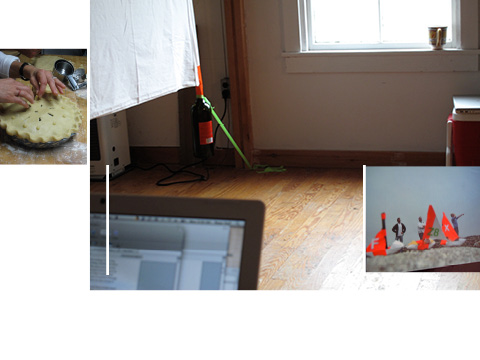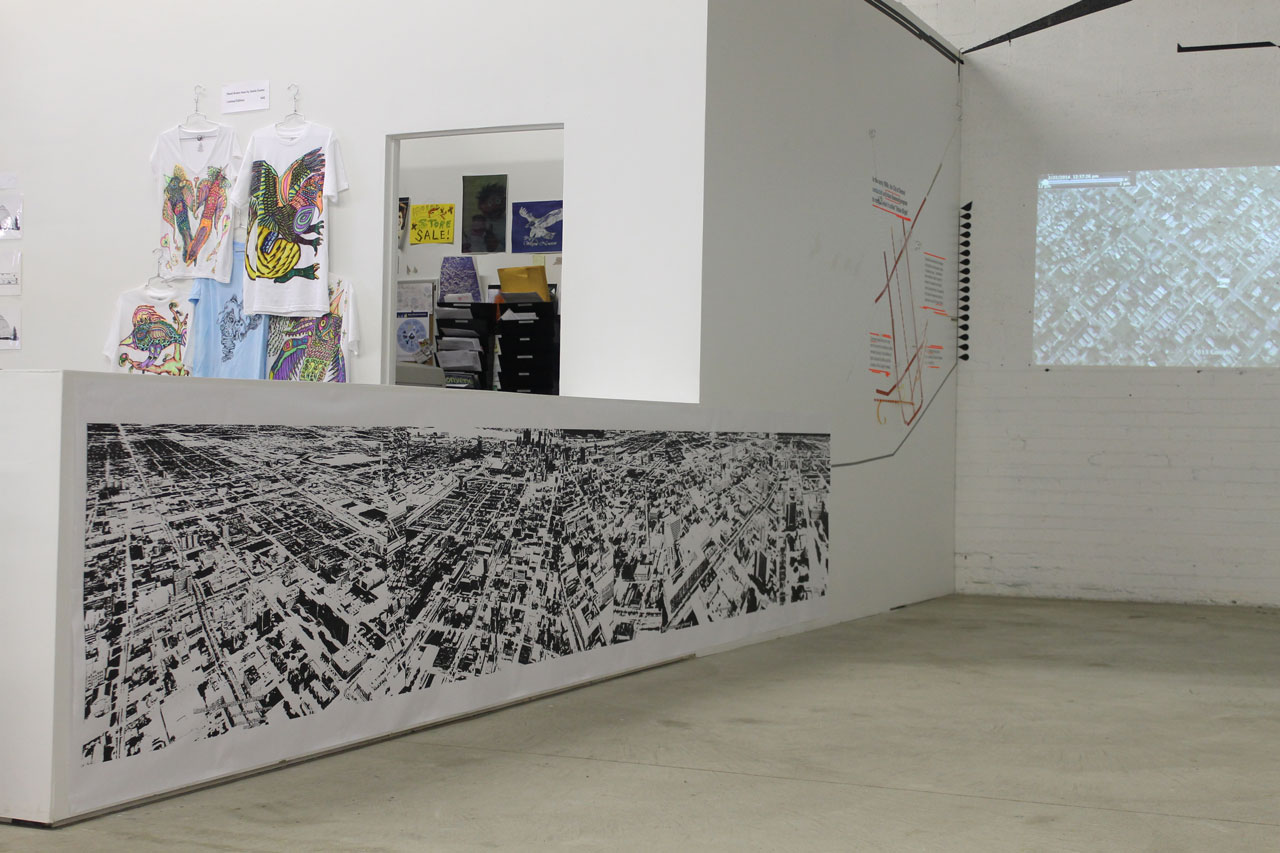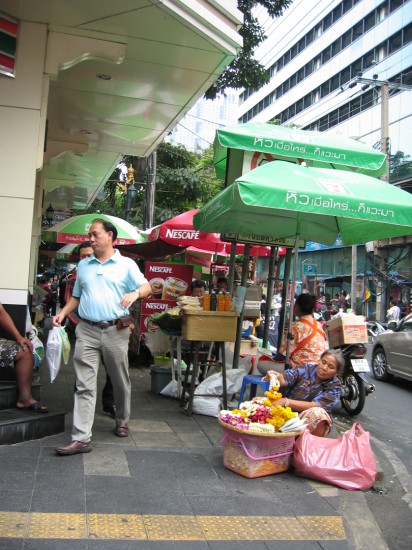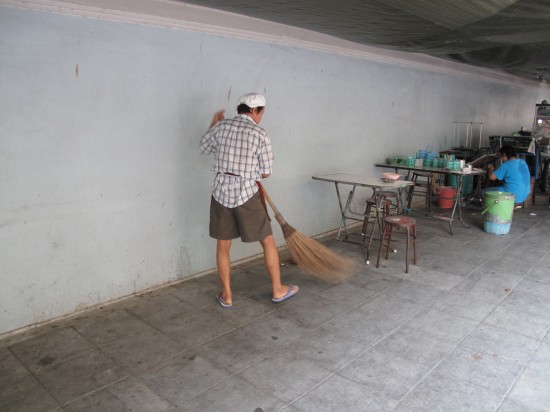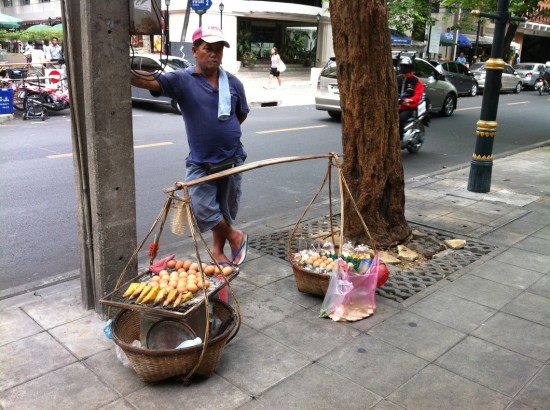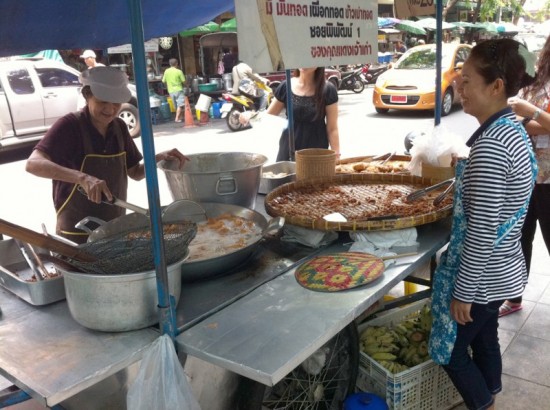(The Case of Soi Convent)
Everyday the streets of Bangkok are shaped by the improvisational culture of street vendors, a make/do phenomenon of organic territorialization. Sidewalks designed for pedestrians often turn into congregations of shoppers and street vendors of a variety of sorts — selling clothes, accessories, music, food and drinks. Tables and stools line sidewalks, transforming a portion of the streets into open-air restaurants — some remaining the whole day while others disappear during off-peak hours. These gatherings reconstruct the urban space into communities and bazaars that are created by citizens operating under an organic social structure.
Just as improvised are the street vending stalls themselves. The designs are often an eclectic mixture of objects and materials that have been given a second life and put together in commonsensical ways to provide functionality, but often with a standardized structure.
On Soi Convent, street vendors line the sidewalks from the break of dawn to hours of the night. During the day, they serve office workers, Bangkokians and tourists; at night, party-goers and more tourists. Soi Convent is located as a side street (soi) that runs off Silom Road, the main commercial street. Within this district stand financial centers such as the headquarters of Bangkok Bank (Thailand’s biggest bank) [1], businesses such as the headquarter of Charoen Pokphand (Thailand’s biggest business conglomerate) [2], shopping centers such as Central Department Store (part of the largest retail conglomerate in Thailand) [3], and entertainment zones such as Silom Soi 4 and Soi Patpong. Street vendors are drawn to this area as customers abound, but contrary to the branded and controlled environments of the surrounding businesses, these street vendors exist as temporary micro commercial entities, loosely strung together into communities as part of the ecosystem of this Southeast Asian metropolis. These communities are self-generated as vendors transition in and out of their occupied space — settling for a period of time before moving away. Some are more transient than others.
This occupancy, albeit temporary, is an after-effect of the “design” of the city. Sidewalks were intended for pedestrians but are now being used for business transactions. They encroach on the common rights of urban space, but through the history of vending in Thai culture, the compromising nature of Thais, the dependency of many Bangkokians for affordable goods as well as the necessity of the majority of Thais to make a living through this informal means, this activity becomes readily embraced on the most part [4] and becomes a social, economic and cultural force that shapes the urban life of Bangkok.
Historically, Thai society existed through self-sufficient means surviving on its own agricultural produce, through the barter system and through civil service. It was not until the arrival of the Chinese that trading began to affect the livelihood of the indigenous Thais. Trading with the Chinese goes as far back as the Sukhothai period (1238). It is thought that the tradition of haab ray may have been influenced by the Chinese: Haab means “to carry” and ray means “to wander”. Hence, the vendor with a bamboo stave balanced on his shoulder and with a basket of goods hung from each end of the pole, wanders into neighborhoods as a direct salesperson, bringing the buying and selling of goods to the doors of consumers; he might also gather with other traders, forming a bazaar.
The territorialization of public space by street vendors and their transient nature can be seen in another aspect of Thai tradition — that of trading by boat. Settlements in the early days of Bangkok were made on the river and canal systems. In 1911, Salvatore Besso, an Italian visiting Bangkok, described this capital city as “Venice of the East” [5]. Houses were built next to and on water. The river and canals acted as transportation routes as well as places of commercial transaction. Trading occurred on the banks and in waterways. Lucian Fournereau wrote of Bangkok in 1892:
“…it is even a most curious sight in the morning to see these thousands of small boats, some of which are not longer than one and a half meters, loaded to the brim with fruits or vegetables with the merchant who disappears under his goods. Sometimes these floating shops group together north of the city and they form various specialized markets… The buyers, also in boats, engage in their commercial transactions. This is the really characteristic and local side of Bangkok.” [6]
As the livelihood of Thais evolved from water to land, the habituation of the past is subconsciously brought to the present: The fluidity of trading on water is reflected in the transient nature of street vendors, and the free use of waterways is reflected in the vendors’ view of public space (of the sidewalks).
Bangkok currently is a metropolis of over nine million [7]. Canals are being filled to make way for roads. Settlements move inland as concrete buildings rise vertically and spread horizontally as a sprawl. Soi Convent sits in the midst of this growth, and it sits in the main commercial district and an entertainment hotspot of Bangkok, making it a much sought-after area for business. Eateries, small businesses, retail shops, office buildings, a hotel and apartment buildings flank both sides of this street. It is also layered by the historical settlement of Westerners and missionaries in Bangkok.
A prestigious Catholic School, a church, a monastery and a hospital are part of this landscape. On a weekday, Soi Convent is teeming with activities. Street vendors line both sides of the soi from the junction on Silom Road to the end of the street only leaving intervals in front of the more regulated buildings such as St. Joseph Convent School, Bangkok Nursing Home Hospital, Q House (office building) and other boutique shops. However, at the confluence, the street stalls selling goods — ranging from clothes to accessories to music — are an extension of the makeshift vending community that occupies this part of Silom Road. People make their way through the narrow space that is left by the vendors — sometimes squeezing past those who stop by to shop and slow down the traffic. The “designs” of the stalls possess a fragile quality (notwithstanding long-term use) that speaks of the convenience in installation and dismantlement.
Sunglasses and Mango snacks
We stopped by to talk to Pii Pook [8] who was selling sunglasses and mango snack. Her stall occupies a small area of about one meter wide at the corner of Silom Road and Soi Convent, but a huge umbrella also marks a more ambiguous territory to her occupancy. She has set up her stall for over ten years and her products have changed from time to time. The display of her sunglasses is configured on a step-like structure that is covered with synthetic fur so as to add presence and a level of sensuality to the glasses. She told us that her stall is designed to lightweight and mobile. The main structure, originally used for a lottery stand, is made of metal tubes. A gridded metal frame creates the tops and plastic baskets act as elevated platforms. Just as candid is the display of the mango snack: two stools stacked one on top of another, topped by a tray containing the snack and a handwritten sign indicating the item and price.
Sidewalks are of course public space meant for pedestrians. However, due to the need by a large part of Thai society to make a living in this informal, low-cost manner, as well as the history of vending in traditional Thai culture, and general advocacy from the public, sidewalks have become shared space between commerce and pedestrians. Certain areas are designated for vending in Bangkok with a fee of approximately 300 Baht per month per vendor (US$10 per month per vendor) for the maintenance of sidewalks that goes to the city. However, fines are also imposed on vendors who do not abide with the charges paid to city officers, or to a person of power such as a mafia who collects them en masse. According to Thai Recent, the online Thai newspaper, each year 100 million Baht (US$3,320,000) are collected from vendors by Bangkok city officers. Half is rewarded to the officers. The same amount or more is collected by the mafia. Vendors, nevertheless, are willing to compromise so as to be able to conduct their business. [9] The multiplicity in the use of public space inevitably reflects the complexity underlying Thai society in terms of culture, politics, and economics. Pii Pook is registered with the district and pays a monthly sidewalk maintenance fee to the city. She conducts business from Monday to Saturday before noon to around seven in the evening. After that the space that she occupies is taken over by other vendors. Her relationship with other vendors and clients is such that she feels that she is part of a community.
Regular clients stop by to greet, and other vendors may sit in for her if she has to be somewhere else. “We look after each other,” she says. An office worker who seems to know the vendors well very energetically chats with the lottery vendor who is located near Pii Pook. At the same time, he is calling out to others to help the sales of lottery. Indeed it feels like a community. When we asked Pii Pook about street vendors’ encroachment of the sidewalk, she very pleasantly said that they know where the limits of their stalls are and take into consideration the pedestrians so that the vendors are not an annoyance. In this micro context of the politics of the sidewalk, there seems to be a sense of conviviality between clients, vendors and state, likely due to the fact that vendors abide by the rules and regulations set up by Bangkok Metropolitan Administration (BMA). “We obey the city officers, keep the area clean as demanded and are considerate of the pedestrians,” Pii Pook told us.
Ground Sales
Adjacent to Pii Pook is another form of street vending. Products of a variety of sorts from flashlights to wallets to perfume are spread in a disorderly manner on merely a piece of cloth that sits on a sheet of plastic. This type of street vending is called bair ga din in Thai. (Bair means “to spread,” ga is the colloquial form for “and”, and din means “ground,” hence, bair ga din are stalls with products displayed on the ground.) This kind of vending is the least permanent and is often carried out by those who have not gained permission to trade on the street. The temporality of their stalls, therefore, besides serving for the ease of mobility, also serves for the quick evasion from city officers as they quickly wrap their goods in their cloth or plastic sheet. The owner of this stall is Pii Noom. [10] He is from Pichit, a province in the north of Thailand. He only sells after the harvesting period is over when there is nothing else to do on the farm. He comes to Bangkok and sets up his stall in this corner of the city, operating daily (except for Mondays) before noon to about seven in the evening. Like Pii Pook, he feels part of the community in this section of Soi Convent. Just as the “design” of his stall is an indication of impermanence, the existence of his stall is equally transitory.
The making-do of street vendors on Soi Convent creates the diversity Jane Jacobs talks about in The Death and Life of Great American Cities, producing microcosms linked together to form a community:
“…both types of ecosystems, [natural and manmade] …require much diversity to sustain themselves. …the diversity develops organically over time, and the varied components are interdependent in complex ways. The more niches for diversity of life and livelihoods in either kind of ecosystem, the greater its carrying capacity for life. In both types of ecosystems, many small and obscure components — easily overlooked by superficial observation — can be vital to the whole…” [11]
As we make our way down the soi during this lunch hour, stalls vary, providing the numerous needs of the office workers, residents, tourists and vendors themselves. It is an ecosystem that provides “something for everybody, only because, and only when, they are created by everybody” as Jacobs put it. [12] People queue up at the fried banana stand or the cart of the fresh fruit vendor. Open-air noodle and rice stalls are filled, as these places provide affordable food to those working and living around this area. However, once lunch hour is over around, food stalls pack up — vendors folding and stacking tables and stools placing them in a trolley, undoing the canvas that acted as a canopy, gathering other equipment that was used for a stall and cleaning up the areas they occupied. Those vacated areas may be left without a replacement or another stall may come to fill in the shift. There is a fluctuation in the occupation of the sidewalk not only by pedestrians but also by vendors making the sidewalk a living body in this urban context.
The politics of the sidewalk is not devoid of friction. The intervention of street vendors in the area by the skytrain at Siam Square has been an issue in the use of public space with the Bangkok Sabai Walk campaign — which advocates for a more walkable Bangkok, particularly in this prime shopping area. At the same time, however, the present government has initiated a “people’s progress” (prachawiwat) policy in order to help the economic means of the lower income sector. More areas (that is, of sidewalks) are being designated for street vending and registered street vendors will be put into the formal sector which would include taxation, but also the security of a place to earn a living. All these vendors have to pay is a monthly maintenance fee for the sidewalk in the amount of 300 Baht per month per vendor (US$10 per month per vendor) and they will be allowed to sell in the designated area under the condition that they obey the rules and regulations set by BMA. [13] This move might bring structure and less unpredictability to the make/do culture of the streets of Bangkok. The occupancy is no longer merely through the power of a certain group of citizens but also through the advocacy of the state. A bottom-up practice by the people is being integrated with the top down approach of the government. Design as strategy and planning is being incorporated into the improvisational practice of street vending.
1. “Bangkok Bank,” http://en.wikipedia.org/wiki/Bangkok_Bank
2. “Charoen Pokphand,” http://en.wikipedia.org/wiki/Charoen_Pokphand
3. “Central Group,” http://en.wikipedia.org/wiki/Central_Group
4. There is currently a dispute between street vendors and Chulalongkorn University’s Management Office over the use of the sidewalk at Siam Square by the skytrain station. “Siam Square Vendors fight Chula’s Plant Pot Project”, 8 Mar. 2011, http://www.nationmultimedia.com/home/Siamsquare-vendors-fight-Chulas-plant-pot-project-30150328.html
5. Marc Askew, “Bangkok: place, practice and representation” (Routledge 2002) P.41
6. Lucien Fournereau, “Bangkok in 1892” (White Lotus 1998) P.21
7. “Bangkok,” http://en.wikipedia.org/wiki/Bangkok
8. Pii Pook. This name is made up for the convenience of identifying with the vendor. (Pii is a title placed in front of a name when addressing a person whose age could be of one’s older sibling.)
9. “People’s Progress for Street Vendors: Who Wins, Who loses?”, 17 Jan. 2011, http://thairecent.com/Bangkok/2011/786722/
10. Pii Noom. This name is made up for the convenience of identifying with the vendor. (Pii is a title placed in front of a name when addressing a person whose age could be of one’s older sibling.)
11. Jane Jacobs, “The Death and Life of Great American Cities” (Modern Library, 1993) p.xvi
12. Jane Jacobs, “The Death and Life of Great American Cities” (Modern Library, 1993)p.312
13. “People’s Progress for Street Vendors: Who Wins, Who loses?”, 17 Jan. 2011,
http://thairecent.com/Bangkok/2011/786722/

